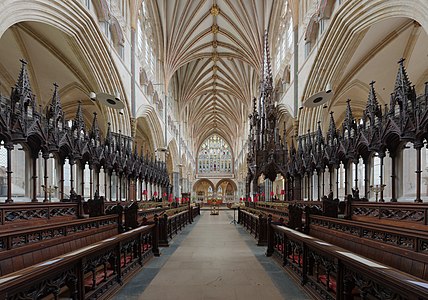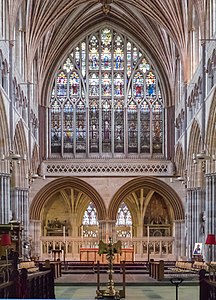Exeter Cathedral
| Exeter Cathedral | ||
|---|---|---|
| Cathedral Church of Saint Peter in Exeter | ||
Canon Treasurer Chris Palmer | | |
| Laity | ||
| Director of music | Timothy Noon | |
Exeter Cathedral, properly known as the Cathedral Church of Saint Peter in Exeter, is an
History
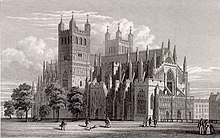



The site where Exeter Cathedral was constructed was home to Roman buildings. A legionary fortress was constructed between 50–75 AD. A Roman bathhouse was discovered in 1971.[3]
The founding of the
In 1107 William Warelwast was appointed to the see, and this was the catalyst for the building of a new cathedral in the Norman style. Its official foundation was in 1133, during Warelwast's time, but it took many more years to complete.[4] Following the appointment of Walter Bronescombe as bishop in 1258, the building was already recognised as outmoded, and it was rebuilt in the Decorated Gothic style, following the example of Salisbury. However, much of the Norman building was kept, including the two massive square towers and part of the walls. It was constructed entirely of local stone, including Purbeck Marble. The new cathedral was complete by about 1400, apart from the addition of the chapter house and chantry chapels.
Like most English cathedrals,
During the Victorian era, some refurbishment was carried out by George Gilbert Scott. As a boy, the composer Matthew Locke was trained in the choir of Exeter Cathedral, under Edward Gibbons, the brother of Orlando Gibbons. His name can be found scribed into the stone organ screen.
In July 2023,
Architecture


The Norman cathedral construction began in 1112, presumably at the east end and was consecrated in 1133, by which date the choir, transept and first two bays of the nave were probably complete. As detailed above, remains of the Norman building can be seen in the massive transept towers. By 1160 the nave and west front were complete, and a cloister and chapter house were added between 1180 and 1244.
During the 1270s, a new project began to replace the entire east end, starting with the east end chapels. This work is documented by a very extensive series of fabric rolls.
By 1328 the church was complete to the first two bays of the nave, where a design change in the vaults is visible. During Master Thomas of Witney's time the east cloister walk was begun (1318–25) and the nave, west front and north cloister walk were probably completed (c.1328-42). That the present west front is on the same site as the Norman predecessor is indicated by the narrowing of the nave bays towards the west, squeezed to meet an existing feature.
The image screen across the west facade and the chantry chapel of Bishop Grandisson located within the west front were probably designed by William Joy, who succeeded Witney as master mason in 1342 but seems to have died in 1347, possibly from the Black Death. From 1377 to 1414 the east, south and west cloister walks were finished by Master Robert Lesyngham, who probably also designed the great East Window (1390–92).
The architecture of Exeter Cathedral at first appears remarkably harmonious with the continuous run of
Notable features
Notable features of the interior include the misericords, the minstrels' gallery, the astronomical clock and the organ. Notable architectural features of the interior include the multiribbed ceiling and the compound piers in the nave arcade.[11]
The 18-metre-high (59 ft) bishop's throne in the choir was made from Devon oak between 1312 and 1316; the nearby choir stalls were made by George Gilbert Scott in the 1870s. The Great East Window contains much 14th-century glass, and there are over 400 ceiling bosses, one of which depicts the murder of Thomas Becket. The bosses can be seen at the peak of the vaulted ceiling, joining the ribs together.[12] Because there is no centre tower, Exeter Cathedral has the longest uninterrupted medieval vaulted ceiling in the world, at about 96 m (315 ft).[6]
-
The nave looking east toward the organ
-
The choir looking east from the organ toward the Lady Chapel
-
The Great East Window
-
The West Window
Misericords

The fifty misericords are the earliest complete set in the United Kingdom.[13] They date from two periods: 1220–1230 and 1250–1260. Amongst other things, they depict the earliest known wooden representation of an elephant in the UK. They have supporters.
Minstrels' gallery

The
Astronomical clock

The
The main, lower, dial is the oldest part of the clock, dating from 1484.
The Latin phrase Pereunt et imputantur, a favourite motto for clocks and
Library


Si quis illum inde abstulerit eterne subiaceat maledictioni. Fiat. Fiat.
(If any one removes this he shall be eternally cursed. So be it! So be it!)
Curse written by Leofric on some of the books in his library[16]
The library began during the episcopate of
In 1412–13 a new lectrinum was fitted out for the books by two carpenters working for 40 weeks. Those books in need of repair were repaired and some were fitted with chains. A catalogue of the cathedral's books made in 1506 shows that the library furnished some 90 years earlier had 11 desks for books and records over 530 titles, of which more than a third are service books.[18]
In 1566 the Dean and Chapter presented to Matthew Parker, Archbishop of Canterbury, a manuscript of the Anglo-Saxon Gospels which had been given by Leofric;[19] in 1602, 81 manuscripts from the library were presented to Sir Thomas Bodley for the Bodleian Library at Oxford. In 1657 under the Commonwealth the cathedral was deprived of several of its ancillary buildings, including the reading room of 1412–13. Some books were lost but a large part of them were saved due to the efforts of Dr Robert Vilvaine, who had them transferred to St John's Hospital. At a later date he provided funds to convert the Lady chapel into a library, and the books were brought back.
By 1752 it is thought the collection had grown considerably to some 5,000 volumes, to a large extent by benefactions. In 1761 Charles Lyttelton, Dean of Exeter, describes it as having over 6,000 books and some good manuscripts. He describes the work which has been done to repair and list the contents of the manuscripts. At the same time the muniments and records had been cleaned and moved to a suitable muniment room.[18]
In 1820 the library was moved from the Lady Chapel to the chapter house. In the later 19th century two large collections were received by the cathedral, and it was necessary to construct a new building to accommodate the whole library. The collections of Edward Charles Harington and Frederic Charles Cook were together more than twice the size of the existing library, and John Loughborough Pearson was the architect of the new building on the site of the old cloister. During the 20th century the greater part of the library was transferred to rooms in the Bishop's Palace, while the remainder was kept in Pearson's cloister library.[18]
Today, there is a good collection of early medical books, part of which came in 1948 from the
Bells
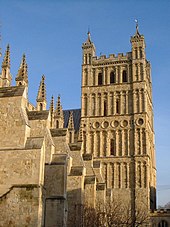
Both of the cathedral's towers contain bells. The North Tower contains an 80-hundredweight (4.1-tonne) bourdon bell, called Peter. Peter used to swing but it is now only chimed.
The South Tower contains the second heaviest peal of 12 bells hung for change ringing in the world, with a tenor weighing 72 long cwt 2 qr 2 lb (8,122 lb or 3,684 kg).[20] They are second only to Liverpool Cathedral in weight.[21] There are also two semitone bells in addition to the peal of 12.[22]
Dean and Chapter
As of 5 December 2020:[23]
- Dean of Exeter — Jonathan Greener (since 26 November 2017 installation)
- Canon Precentor — James Mustard (since 25 March 2018 installation)
- Canon Chancellor — Chris Palmer (since 5 August 2018 installation)[24]
- Canon Steward — Cate Edmonds (SSM; (residentiary canon) since 22 October 2019 installation)[25]
- Non-Canons[26]
- Priest Vicar — Ian Morter (Canon Treasurer & Pastor 2010–2017; Priest Vicar since June 2018)
- Priest Vicar — Julian Ould
Burials
A full listing of monuments and transcription of inscriptions in the cathedral is contained in:
Persons buried within the cathedral include the following:
- Leofric (bishop), first Bishop of Exeter (1050–1072)
- Robert Warelwast, Bishop of Exeter (1138–1155)
- Bartholomew Iscanus, Bishop of Exeter (1161–1184)
- John the Chanter, Bishop of Exeter (1186–1191)
- Henry Marshal, Bishop of Exeter (1194–1206)
- Simon of Apulia, Bishop of Exeter (1214–1223)
- Walter Bronescombe, Bishop of Exeter (1258–1280)
- Peter Quinel, Bishop of Exeter (1280–1291)
- Henry de Bracton (c. 1210 – c. 1268), English ecclesiastic and jurist
- Sir Henry de Raleigh (died 1301), knight
- Walter de Stapledon, Bishop of Exeter (1308–1326)
- Sir Richard de Stapledon (died 1326), knight, elder brother of Bishop Stapledon
- James Berkeley (died 1327), Bishop of Exeter
- John Grandisson, Bishop of Exeter (1327–1369)
- Hugh Courtenay, 2nd Earl of Devon(1303–1377) and his wife Margaret de Bohun (died 1391)
- Thomas de Brantingham, English lord treasurer and Bishop of Exeter (1370–1394)
- Sir Hugh Courtenay, 2nd Earl of Devon
- William Wilford (died 1413), Steward, Exeter Mich. 1396–7; receiver 1397–8; Member of the council of 12 1398–9, 1401–2, 1403–4, 1405–6, 1407–8, 1409–10, 1411–12; Mayor of Exeter 1400–1, 1402–3, 1404–5, 1406–7, 1408–9, 1410–11, 1412–13.
- Edmund Stafford, Lord Privy Seal, Lord Chancellor, Baron Stafford and Bishop of Exeter (1395–1419)
- Edmund Lacey, Bishop of Exeter (1420–1455), whose tomb had been a shrine, but which was walled over during the Reformation, fragments were uncovered during the Baedeker Blitz[27]
- Bramford Speke, Devon (buried in the Speke Chantry)
- Hugh Oldham, Bishop of Exeter (1504–1519; buried in the Oldham Chantry)
- William Alley, Bishop of Exeter (1560–1571)
- William Bradbridge, Bishop of Exeter (1571–1578)
- John Woolton, Bishop of Exeter (1579–1594)
- Dr. William Cotton, Bishop of Exeter (1598–1621) buried in Exeter Cathedral. His monument with recumbent effigy survives.
- Ofspring Blackall (1655–1716), Bishop of Exeter (1708–1716) buried on the southern side of the choir in an unmarked grave
- John Ross (1719–1792), Bishop of Exeter (1778–1792) buried in the south aisle of the choir, the place being marked by a flat tombstone and the inscription 'J. R., D.D., 1792.'
- Bryan Blundell (1757–1799), Major General in the Army and Lieutenant Colonel of the 45th Regiment of Foot
- Sir Gawen Carew
- Peter (Pierre) of Courtenay (1126–1183), youngest son of Louis VI of France and his second Queen consort Adélaide de Maurienne.
- Sir Peter Carew (c. 1514 – 1575) is not buried in the cathedral, but is commemorated by a mural monument.
- George Knight-Bruce, Bishop of Bloemfontein (1886- 1891) and first Bishop of Mashonaland (now Harare)(1891–1895) is commemorated by a memorial tablet.
-
Effigies of Hugh Courtenay, 2nd Earl of Devon, and his wife Margaret de Bohun
-
Rubbing from monumental brass of Sir Peter Courtenay, Exeter Cathedral, south aisle
-
Mural monument to Sir Peter Carew, south transept
-
Wall tablet to Major-General Bryan Blundell Esq, north east chapel
-
Wall tablet commemorating George Knight-Bruce, first bishop of Mashonaland (now Harare)
Legends

One 19th-century author claimed that an 11th-century
According to the semi-legendary tale, the Protestant martyr Agnes Prest, during her brief time of liberty in Exeter before her execution in 1557, met a stonemason repairing the statues at the cathedral. She stated that there was no use repairing their noses, since "within a few days shall all lose their heads".[29] There is a memorial to her and another Protestant martyr, Thomas Benet, in the Livery Dole area of Exeter. The memorial was designed by Harry Hems and raised by public subscription in 1909.[30]
Wildlife
The tube web spider Segestria florentina, notable for its iridescent shiny green fangs, can be found within the outer walls. The walls are made of calcareous stone, which decays from acidic pollution, to form cracks and crevices which the spider and other invertebrates inhabit.[31]
Music
Choir

Exeter Cathedral Choir is composed of 38 Choristers (boys and girls) along with Choral Scholars and Lay Vicars. There is also a voluntary choir, the St Peter's singers, dating back to 1881.[32]
Organists
Recorded names of organists at Exeter go back to Matthew Godwin, 1586. Notable organists at Exeter Cathedral include Victorian composer
Organ
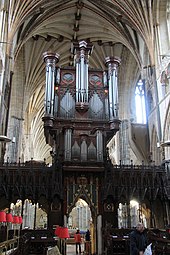
The Cathedral organ stands on the ornate medieval screen, preserving the old classical distinction between
In January 2013 an extensive refurbishment began on the organ, undertaken by Harrison & Harrison. The work consisted of an overhaul and a re-design of the internal layout of the soundboards and ranks of the organ pipes.[36] In October 2014 the work was completed and the organ was reassembled, save for the final voicing and tuning of the new instrument.[37]
See also
- Dean of Exeter
- Exeter Cathedral School
- Exeter monastery
- Myles Coverdale Bishop of Exeter, 1548–1553
- List of cathedrals in the United Kingdom
- List of Gothic Cathedrals in Europe
- Architecture of the medieval cathedrals of England
- Romanesque architecture
References
- ^ "TimeRef - Medieval and Middle Ages History Timelines - Exeter Cathedral Details". www.timeref.com. Archived from the original on 2 April 2017. Retrieved 2 April 2017.
- ^ a b "Dove Details". dove.cccbr.org.uk. Retrieved 2 December 2018.
- ^ Nalewicki, Jennifer (7 May 2024). "1,900-year-old Roman legionary fortress unearthed next to UK cathedral". Live Science. Archived from the original on 9 May 2024.
- ^ Erskine et al. (1988) p. 11.
- required.)
- ^ a b c d e The Cathedral Church of St Peter in Exeter. Printed leaflet distributed at the Cathedral. (2010)
- ^ S C Carpenter (1943) Exeter Cathedral 1942. London: SPCK p. 1-2
- ISSN 0022-0469.
- ^ a b "Exeter – Tracing the Past: Medieval Vaults". Retrieved 1 September 2021.
- ISBN 9780901286277.
- ISBN 978-0205790944.
- ISBN 978-0205790944.
- ^ "The Exeter Misericords". Exeter Cathedral. Archived from the original on 15 August 2010. Retrieved 23 August 2010.
- ^ Addleshaw (1921) p. 36
- ^ "Bagpipe Paintings: The Bagpiper of Exeter". prydein.com. Prydein, American Celtic-Rock. Archived from the original on 31 July 2016. Retrieved 17 December 2016.
[photos of the Minstrels Gallery]
- .
- )
- ^ a b c d Lloyd, L. J. (1967) The Library of Exeter Cathedral. Exeter: University of Exeter
- ^ Sayle, Charles (1916). Annals of Cambridge University Library, 1278-1900. Cambridge: University Library. p. 49 (footnote 3). Archived from the original on 6 March 2016. Retrieved 29 July 2016.
- ^ "Doves Guide for Bellringers". Retrieved 28 July 2014.
- ^ "Dove's Guide Search". dove.cccbr.org.uk. Retrieved 2 December 2018.
- ^ "Rings of 12". The Rings of 12. Archived from the original on 21 February 2015. Retrieved 28 July 2014.
- ^ Exeter Cathedral — Chapter Members (Accessed 5 December 2020)
- ^ "Appointment of Canon Chancellor". Exeter Cathedral. 25 March 2018. Archived from the original on 30 January 2019. Retrieved 30 January 2019.
- ^ "Cathedral News issue 691" (PDF). Exeter Cathedral. November 2019. Archived (PDF) from the original on 5 December 2020.
- ^ Exeter Cathedral — Cathedral Clergy Archived 16 August 2018 at the Wayback Machine (Accessed 7 January 2018)
- ^ Stephan, D.John (24 September 1955). "A Forgotten Shrine". The Tablet. Archived from the original on 19 August 2014. Retrieved 18 August 2014.
- ^ Jusserand, J. J. (1891) English Wayfaring Life in the Middle Ages. London: T. Fisher Unwin; p. 327.
- ^ John Foxe (1887 republication), Book of Martyrs, Frederick Warne and Co, London and New York, pp. 242–44
- ^ Cornforth, David. "Livery Dole Martyr's Memorial". Exeter Memories. Archived from the original on 6 April 2012. Retrieved 17 December 2011.
- ^ Wild Devon The Magazine of the Devon Wildlife Trust, pages 4 to 7 Winter 2009 edition
- ^ "Exeter Cathedral Choir leads around eight services each week". Exeter Cathedral. Archived from the original on 14 January 2020. Retrieved 6 February 2020.
- ^ "Timothy Noon".[permanent dead link]
- ^ a b "The National Pipe Organ Register - NPOR". www.npor.org.uk.
- ^ "Exeter Cathedral". Harrison-organs.co.uk. Archived from the original on 6 March 2012. Retrieved 18 September 2012.
- ^ "Organ Restoration Begins". Exeter Cathedral Website. Archived from the original on 22 October 2014. Retrieved 14 October 2014.
- ^ "Cathedral organs". Exeter Cathedral website. Archived from the original on 6 October 2014. Retrieved 14 October 2014.
Sources
- Addleshaw, Percy (1921). Bell's Cathedrals: The Cathedral Church of Exeter (New and revised ed.). G. Bell & Sons, London. Online copy
- here at Project Gutenberg
- Erskine, Audrey; Hope, Vyvyan; Lloyd, John (1988). Exeter Cathedral - A Short History and Description. Dean and Chapter of Exeter Cathedral. ISBN 0-9503320-4-6.
Further reading
- Henry, Avril K.; Hulbert, Anna C. "Exeter Cathedral Keystones & Carvings: A Catalogue Raisonné of the Sculptures & Their Polychromy". Universities of Essex – History Data Service. Retrieved 23 August 2010.
- Barlow, Frank, et al. (1972) Leofric of Exeter: essays in commemoration of the foundation of Exeter Cathedral Library in A.D. 1072; by Frank Barlow, Kathleen M. Dexter, Audrey M. Erskine, L. J. Lloyd. Exeter: University of Exeter
- Orme, Nicholas (2009) Exeter Cathedral: the first thousand years, 400-1550. Exeter: Impress ISBN 0-9556239-8-7(a history of the successive churches on the site from Roman to early Tudor times)
External links
- Official website
- THE CATHEDRAL CHURCH OF EXETER, A DESCRIPTION OF ITS FABRIC AND A BRIEF HISTORY OF THE EPISCOPAL SEE BY PERCY ADDLESHAW,, public domain on Project Gutenberg Archived 9 August 2016 at the Wayback Machine
- Monuments in Exeter Cathedral (Church Monument Society)
- Pictures of the Minstrel's Gallery.
- A painting of Interior of Exeter Cathedral by Thomas Allom engraved by E Challis for Fisher's Drawing Room Scrap Book, 1834, as an illustration to Letitia Elizabeth Landon's poem
 The Missionary..
The Missionary..


